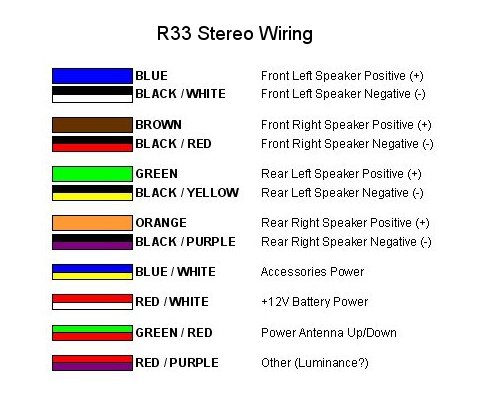Decoding Car Speaker Wire Colors: Your Guide to a Perfect Audio Setup
Ever peered behind your car stereo, baffled by a tangle of multicolored wires? You’re not alone. The cryptic world of car speaker wire colors can be intimidating, but understanding it is key to unlocking your car's audio potential. This guide will demystify those color codes, empowering you to confidently install or troubleshoot your car's sound system.
Car speaker wire colors are the silent language of your vehicle's audio system. They dictate which wire connects to which speaker terminal, ensuring that the right signal reaches the right driver. Ignoring these color conventions can lead to reversed polarity, blown speakers, and a generally frustrating audio experience.
The standardized color codes we use today weren't always around. Early car audio systems relied on less systematic approaches, often leading to confusion and miswiring. The evolution to a standardized color scheme simplified installations and made car audio more accessible to the average enthusiast. This standardization is vital, as it allows for seamless integration of aftermarket components from various manufacturers.
Why does this matter? Correctly interpreting car audio wire colors is fundamental to achieving proper speaker phasing. This ensures that your speakers move in harmony, creating a rich, balanced soundstage. Incorrect wiring can lead to phase cancellation, where sound waves interfere destructively, resulting in a thin, weak audio output.
Understanding these color codes isn't just about getting sound; it's about getting the right sound. It's the difference between a muddy, distorted mess and a crisp, clear audio experience that truly brings your music to life.
Typically, speaker wires are coded in pairs. One wire will have a solid color, and its partner will be the same color with a black stripe. Common colors include gray, white, green, and purple. For example, a gray wire paired with a gray/black wire would represent one speaker connection.
One of the biggest benefits of adhering to standard car speaker wire colors is simplified troubleshooting. If you experience an audio issue, knowing the color codes allows you to quickly isolate the problem area. This can save you valuable time and money, preventing unnecessary replacements of perfectly good components.
Another advantage is the ease of upgrading or expanding your sound system. Whether you're adding new speakers, an amplifier, or a subwoofer, the standardized color scheme simplifies integration. This allows for a seamless transition, minimizing potential compatibility issues.
Furthermore, understanding speaker wire colors empowers you to take control of your car's audio destiny. You no longer need to rely solely on professional installers for even minor modifications. This not only saves you money but also fosters a deeper understanding of your vehicle's audio system.
Advantages and Disadvantages of Standardized Car Speaker Wire Colors
| Advantages | Disadvantages |
|---|---|
| Simplified Installation | Occasional Manufacturer Variations |
| Easy Troubleshooting | Potential for Confusion with Aftermarket Wiring |
| Seamless System Upgrades | Limited Color Options for Complex Systems |
Best practices for working with car speaker wire colors include using high-quality wiring, securing connections with proper connectors, and carefully routing wires to prevent interference and damage. Always consult your car's wiring diagram to confirm the specific color codes for your vehicle.
Frequently Asked Questions:
1. What do the different colors mean? The colors differentiate the positive and negative terminals of different speakers.
2. What if my car's wiring doesn't match the standard codes? Consult your car's wiring diagram.
3. Can I use different colored wires? While you can, it's highly discouraged as it can lead to confusion and miswiring.
4. What gauge wire should I use? The appropriate gauge depends on the power of your system. Consult a car audio specialist for recommendations.
5. How do I test speaker polarity? Use a simple 1.5V battery to briefly connect to the speaker terminals and observe the cone movement.
6. What if I hear distorted sound after wiring? Double-check your connections and ensure proper polarity.
7. Where can I find a wiring diagram for my car? Check your owner's manual or online resources.
8. How can I identify the positive and negative wires in a pair? The striped wire is typically the negative.
Tips and Tricks: Label your wires as you disconnect them to avoid confusion later. Use a multimeter to verify connections and test for continuity.
In conclusion, understanding car speaker wire colors is an essential aspect of car audio installation and maintenance. From simplified troubleshooting to seamless system upgrades, mastering this color code empowers you to take control of your vehicle’s sound. By following best practices and utilizing the resources available, you can transform your car into a rolling concert hall. Remember, the correct wiring is not only about getting sound; it’s about getting a clean, balanced, and immersive audio experience that truly elevates your driving experience. Invest the time to learn these codes, and your ears will thank you. So, dive in, decode those colors, and unlock the full potential of your car’s audio system. You might be surprised at the difference a little understanding can make. Don’t be intimidated by the colorful chaos behind your dashboard. With a little knowledge, you can conquer the world of car audio wiring and enjoy the sweet sounds of success.
Inked in friendship a look at small best friend tattoos for women
Flattering hairstyles for women over 50 exploring medium length layered and choppy cuts
Biggest country music stars a deep dive into nashvilles elite













